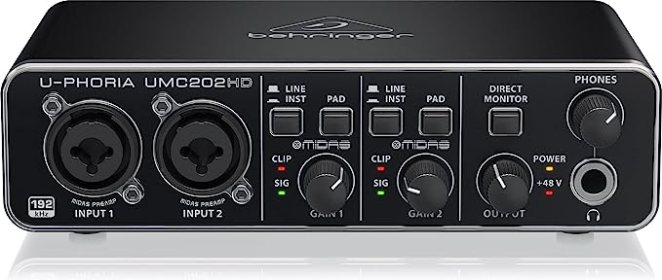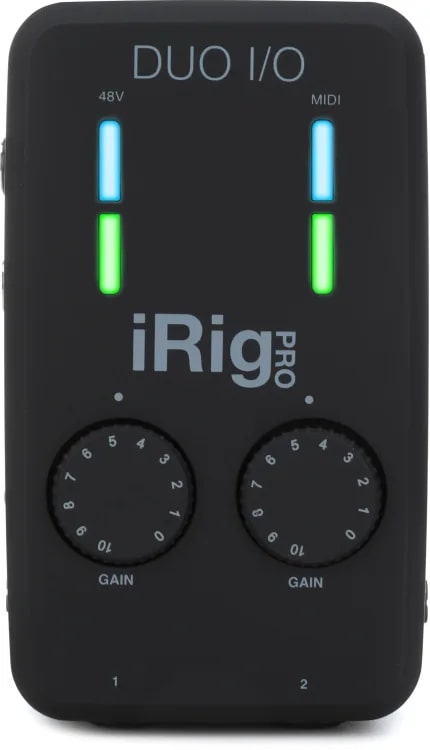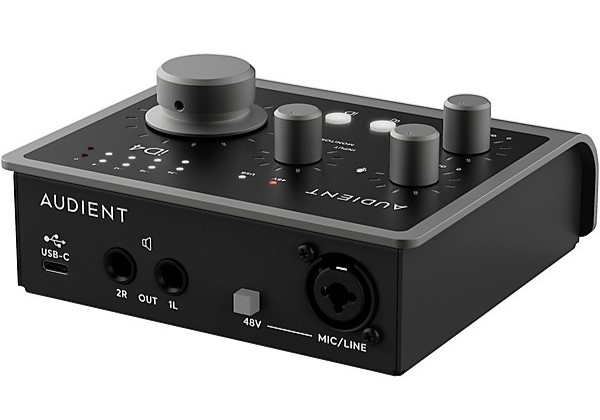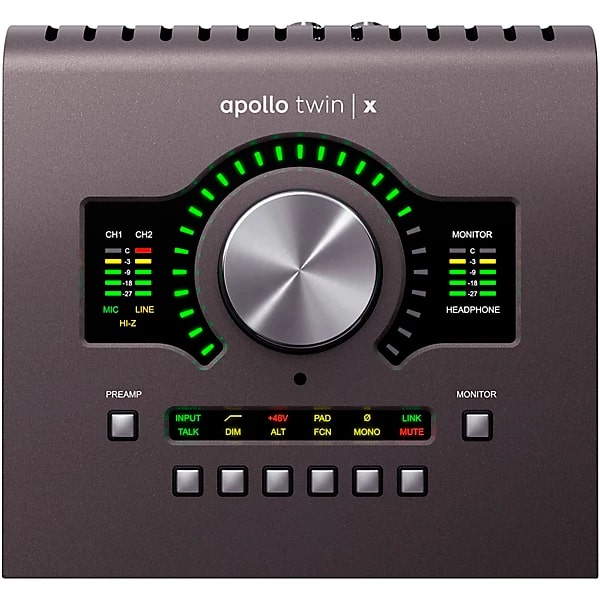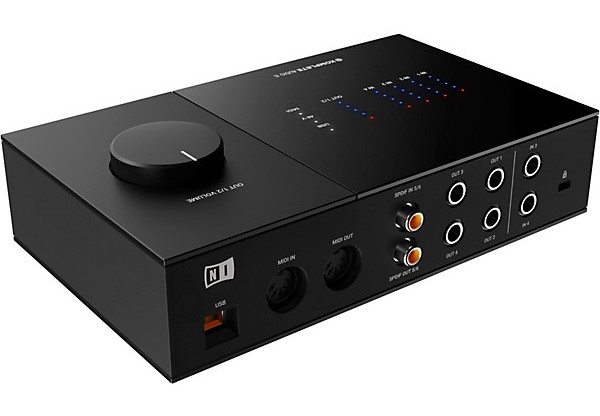When you buy through our links, we may earn an affiliate commission.
Would you like to record your music at the highest fidelity possible without booking an expensive recording session?
Then, an audio interface is just what you're looking for — these little pieces of gear will be the cornerstone of your home studio, allowing you to record every drop of inspiration that comes up.
In this article, we'll explore the best audio interface for every use case, no matter if you're an expert or an enthusiast just starting out. We also included a buyer's guide that covers the most important aspects you should keep in mind while shopping for an audio interface.
Our #1 pick is the Focusrite Scarlett 18i20 — an absolute powerhouse of an interface that combines versatility, style, and sound quality at an affordable price.
The right audio interface will allow you to track each of your instruments with high fidelity while also being easy to use and compact. Let's find the perfect interface for you!
Quick Summary of the Best Audio Interface
- Focusrite Scarlett 18i20 (Best Overall)
- Behringer U-Phoria UMC202HD (Best for Those on a Budget)
- Focusrite Scarlett 2i2 4th Gen (Best for Home Studios)
- Behringer U-Phoria UMC1820 (Best for Budget I/O)
- Arturia AudioFuse 16Rig (Best for Quality)
- IK Multimedia iRig Pro Duo (Best for Portable Setups)
- Focusrite Clarett+ 4Pre (Best Interface With ADAT)
- Audient iD4 MKII (Best for Streamers)
- Universal Audio Apollo Twin X DUO (Best for Mac)
- Native Instruments Komplete Audio 6 (Best for Bands)
- Arturia MiniFuse 2 (Best for Electronic Music)
Best Audio Interface
Best Overall
SPECS
- I/O: 18-in, 20-out
- A/D resolution: Up to 24-bit/192kHz
- MIDI connectivity: In/Out
The Focusrite Scarlett 18i20 is a true beast among audio interfaces. Affordable, high-quality, versatile, and stylish, this device is our top contender for the best USB audio interface on the market.
Delivering up to 18 input channels and 20 outputs simultaneously, the Scarlett 18i20 is the perfect pick for producers who want to solve all I/O issues at once. Custom-made preamps and switchable phantom power are available for each input, as well as the characteristic Focusrite Air mode.
Regarding the overall quality, the Scarlett 18i20 offers an astonishing sampling rate of 192kHz with a 24-bit resolution. Furthermore, the super-low latency allows you to monitor your inputs in real time — even if they're going through dozens of plugins.
Best for Those on a Budget
SPECS
- I/O: 2-in, 2-out
- A/D resolution: Up to 24-bit/192kHz
- MIDI connectivity: No
Behringer has become the frontline for producers on a budget — and the Behringer U-Phoria UMC202HD is, by far, the best example of this. A one-stop-shop for home studios and amateur producers, this audio interface provides everything you need to get the ball rolling.
The UMC202HD offers two inputs with switchable +48V phantom power and input pads to accommodate any possible instrument or mic. On the back, you'll find two 1/4" outputs, while on the front, there's a headphone output with a direct monitoring option.
But where the UMC202HD really shines is in its A/D resolution — despite its ridiculously affordable price, it offers a sampling rate of 192kHz with a 24-bit resolution. This is more than enough to compete with most of the best audio interfaces on the market, giving you that professional sound without breaking the bank.
Best for Home Studios
SPECS
- I/O: 2-in, 2-out
- A/D resolution: Up to 24-bit/192kHz
- MIDI connectivity: No
The Focusrite Scarlett 2i2 has become a staple among amateur producers thanks to its sleek look and astonishing quality. Being the cheapest entry on the Scarlett line, the 2i2 provides every signature Focusrite feature at an affordable price.
Much like the UMC202HD, the Scarlett 2i2 comes with two versatile inputs that can handle mic-, instrument-, and line-level gear. Similarly, you'll find a headphone output on the front and two 1/4" outputs on the back.
However, the 2i2 offers some extra features that can make a difference. Auto gain, clip safe, LED indicators, and loopback capabilities are some of those key functionalities that set the Scarlett interfaces from the competition.
It's also our top pick for the best audio interface for podcasters.
Best for Budget I/O
SPECS
- I/O: 18-in, 20-out
- A/D resolution: Up to 24-bit/96kHz
- MIDI connectivity: In/Out/USB
Any veteran producer knows that there are very few options for those looking for affordable interfaces with more than four inputs and outputs. Luckily, the U-Phoria UMC1820 comes to solve just that — and boy does it do it well.
Providing up to 18 inputs and 20 outputs simultaneously, the UMC1820 wants to solve all your I/O problems without sacrificing audio quality in the process. While the sampling rate isn't as high as our previous entries, 96kHz is more than enough for most recording sessions.
You can think of the Behringer UMC1820 as a bigger UMC202HD. If you're looking to record a band, a drum kit, or an entire live gig, the UMC1820 is perfect for you.
Best for Quality
SPECS
- I/O: 16-in, 12-out
- A/D resolution: Up to 24-bit/192kHz
- MIDI connectivity: 1-in, 2-out/thru, USB
There are few things that can increase the quality of your studio as a professional, state-of-the-art USB audio interface. The Arturia AudioFuse 16Rig wants to accomplish just that, providing mind-blowing sound quality and a stylish rackmount design.
While the price tag is a bit higher than our previous entries, we can assure you no regrets exist when it comes to the AudioFuse 16Rig. Its all-analog design and top-of-the-line converters allow your signals to go through without dirt.
Furthermore, the AudioFuse 16Rig can be a standalone powerhouse for DAW-less jams. This versatile USB interface can work without a computer, allowing you to mix, organize, and sequence audio and MIDI signals for those times when you're just looking to space out.
Best for Portable Setups
SPECS
- I/O: 2-in, 2-out
- A/D resolution: Up to 24-bit/48kHz
- MIDI connectivity: In/Out
Nowadays, there are a lot of producers looking to step away from the traditional home studio setup. Whether you're looking for an interface that works with your mobile devices or just want to take your setup on the road, the IK Multimedia iRig Pro Duo has got you covered.
The iRig Pro Duo wants to give you the chance to catch your inspiration as it happens — no matter where you are. This compact interface can be powered by batteries, USB, or power supply, giving you endless options for recording on the fly.
While the A/D resolution may not be as high as other modern interfaces, the IK Multimedia iRig Pro Duo prioritizes portability and compatibility above all else. It may even be the best choice for you if you want to record top-quality content for social media!
Best Interface With ADAT
SPECS
- I/O: 18-in, 8-out
- A/D resolution: Up to 24-bit/192kHz
- MIDI connectivity: In/Out
Once again, Focusrite takes the prize for the best USB audio interface with ADAT. The Clarett+ 4Pre comes equipped with four mic inputs and four line inputs, but its extra ADAT input extends its I/O range by a fair margin.
This means you can connect up to 16 different instruments at the same time — and that's not even taking into account the bonus S/PDIF pair. All in all, the Focusrite Clarett+ 4Pre lets you record an entire band from your home studio without sacrificing the compact and sleek format.
Of course, all the usual Focusrite perks are included: Air preamp, mobile control software, bundled plugins, and everything else. If you're a home studio artist looking for an upgrade, you just can't skip this one.
Best for Streamers
SPECS
- I/O: 2-in, 2-out
- A/D resolution: Up to 24-bit/96kHz
- MIDI connectivity: No
Now, not everyone needs an absolute powerhouse of an interface with dozens of inputs and outputs. Streamers, content creators, or even gamers who love voice chat may just need a powerful interface that's easy to use — and that's where the Audient iD4 MKII comes in.
The tiny size and simplistic looks may not seem like it, but rest assured that the iD4 MKII packs everything you could possibly need. High-quality converters, wide headroom, analog circuits, and low latency are some (but not all) of the key features of this tiny beast.
Learning how it works shouldn't take more than an hour or two — even if you're a complete beginner to audio. Plus, each unit comes with the ARC software suite included, which provides plugins and courses for no extra cost.
Best for Mac
SPECS
- I/O: 10-in, 6-out
- A/D resolution: Up to 24-bit/192kHz
- MIDI connectivity: No
Mac is somewhat of a golden standard in the music production industry, yet somehow a lot of interfaces are missing non-USB connections. The Universal Audio Apollo Twin X DUO is here to change that, providing an exclusive Thunderbolt port to satisfy even the most demanding producers and their iOS devices.
The high-quality audio parallels that of much more expensive audio interfaces thanks to the elite DUO Core processor and Dual Unison preamps. Pair that with the almost-zero latency of Thunderbolt, and you have the future of music-making in your hands.
But another key feature of the Universal Audio Apollo Twin X DUO is its obsession with analog gear. The included bundled software and the versatile preamps allow you to track your inputs through different vintage gear, such as the 610 tube preamp.
Best for Bands
SPECS
- I/O: 6-in, 6-out
- A/D resolution: Up to 24-bit/192kHz
- MIDI connectivity: In/Out
The Native Instruments Komplete Audio 6 is the perfect choice for those who want a versatile interface that can pretty much work on its own. An all-in-one solution, this monster of an interface lets you record entire bands and gigs without overwhelming you with features.
The seamless integration with Native Instrument's software makes it perfect for Kontakt users. With six inputs, six outputs, and MIDI ports, the Komplete Audio 6 clashes the world of analog sound with digital in the blink of an eye.
And, naturally, the software included is nothing short of amazing — all of the essential Native Instrument's FX and instruments are included here. Did we mention this is also a budget choice? Just check the price.
Best for Electronic Music
SPECS
- I/O: 2-in, 2-out
- A/D resolution: Up to 24-bit/192kHz
- MIDI connectivity: In/Out/USB
If you're an electronic producer who's not planning to record multiple instrument inputs at once, the Arturia MiniFuse 2 is for you. This compact interface is set on giving you a streamlined workflow, free of distractions and focused on digital music-making.
The combo preamps, however, are there to ensure you get top-notch sound quality whenever you decide to plug in your instruments. One of the best features the MiniFuse 2 offers is the dedicated headphone controls — a perk not too common in this price range.
But the one feature you can't gloss over is the stereo virtual loopback channel, which allows you to capture computer audio at all times. It's rare to see loopbacks in audio interfaces — yet sample enthusiasts and content creators are sure to fall in love with it.
Best Audio Interface Buyer's Guide
Navigating the world of audio interfaces can be quite a challenge if you're new to recording music. Packed with dozens of features, inputs, and outputs, USB audio interfaces are among the most complex pieces of gear in the music world.
But fret not! Here, we've compiled a buyer's guide to help you find a good USB audio interface that'll accommodate all your recording needs. While this doesn't cover every aspect there is to buying a good audio interface, we believe there are four fundamental specs to keep in mind:
Sampling Rate
The sampling rate is the frequency at which the audio interface takes "snapshots" of the sound — you can think of it as how a camera captures video by taking a lot of pictures. These snapshots are then used to recreate the original analog signal in your computer.
While you may think that a higher sampling rate is automatically better, the theory says otherwise. According to a phenomenon called the "Nyquist–Shannon sampling theorem," you only need about 44100Hz to capture all of the audible frequencies at near-perfect fidelity.
Yet, the best audio interfaces nowadays go way over this number, offering up to 192kHz resolution. This helps capture the higher frequencies a bit better, giving your sound that extra professional studio sound. But remember that getting less than that shouldn't pose any major problems!
Bit-depth
If the sampling rate is similar to taking a snapshot, the bit-depth determines the quality of the snapshot itself. In short, the bit rate allows the computer to place your signal on the Y axis, which represents polarity and volume at a very early instance of the analog-to-digital conversion.
A low bit-depth will result in a noisy recording process, as the interface has to go through rounding errors to fit the signal in the given bit range. Going below 8-bit will usually yield completely useless audio files that are not only opaque but also covered in background noise.
Luckily, most modern DAWs and universal audio interfaces can handle upward of 16-bit (the CD standard) by default. Going anywhere over 24-bit is usually overkill, as most recording engineers recognize that 16-bit and 24-bit are enough to capture any signal.
Mic-, line-, and instrument-level inputs
You may have noticed that most modern audio interfaces offer three kinds of inputs: mic-, line-, and instrument-level. The differences between each of these mostly have to do with input gain, as different gear will require different ways of amplification.
Line inputs are by far the loudest, with signals usually being between -10 and +4 dB loud. Line instruments, such as synths, output a signal that's ready to be taken by audio interfaces and require little to no amplification. The same also applies to line outputs.
Instrument inputs, on the other hand, usually oscillate between -30 and -10 dB. Also known as Hi-Z inputs, instrument-level inputs are also equipped with a higher impedance to properly handle the difficulties of magnetic pickups found on electric guitars and basses.
Last but not least, microphone inputs take on signals that are between -60 and -30 dB. These also often come equipped with phantom power — an optional 48v current that powers up certain microphones (usually condensers) without needing external power sources.
Included Software Package
Now, it's easy to gloss over the software bundle included in most USB audio interfaces. However, if you're new to audio recording or a home studio user, this bundle may be just what you need to upgrade your recording space.
Plug-ins, DAWs, courses, and standalone utilities are some of the most common perks included in these bundles. Taking into account that a DAW license or a world-renowned plugin can cost close to a thousand dollars, skipping out on these freebies would most certainly be a mistake.
For example, most Focusrite interfaces (such as the Scarlett 18i20) come with Antares Auto-Tune, Native Instrument Massive, and Ableton Live Lite included. This bundle on its own could cost upward of 200 dollars, making Focusrite products a bargain when compared to its competitors.
Frequently Asked Questions (FAQs)
Do expensive audio interfaces sound better?
As with all things related to music gear, more expensive doesn't necessarily mean better — although it does help. Pricier audio interfaces usually have better A/D resolutions, preamps, converters, and circuits, which help capture your signal with pristine quality.
But, of course, there are exceptions to this. The Behringer U-Phoria UMC202HD, for example, manages to offer top-notch fidelity at a reasonable price. However, this may not be an option for you if you're looking for ample I/O capabilities or other bonus perks.
Should I use a DAC or audio interface?
The answer to this is surprisingly simple: if you're looking to record anything, an audio interface is the right option for you. A DAC (digital-to-analog converter) is used almost exclusively for listening to music, as its only function is to convert digital signals into analog outputs that can be sent to amps and speakers.
However, this doesn't mean that DACs are no good — if you want to have the best listening fidelity possible, DACs can provide astonishing resolutions that audio interfaces can't even dream of. Some DACs offer up to 32bit/384kHz or even 32bit/768kHz!
Do computers have built-in DACs?
Yes, any computer with a speaker has a DAC included. If the computer also allows any kind of input, this would be closer to a built-in audio interface. These are often referred to as "sound cards" — you can think of them as a barebone version of an external audio interface.
So why do producers buy external interfaces? Well, to put it simply, built-in sound cards just aren't enough to record at a high fidelity. The integrated computer interfaces are usually very limited in terms of I/O, audio resolution, and other features key to recording music.
Verdict
We know that buying a USB audio interface can seem like a daunting task — however, understanding a few concepts will help you find the perfect pick for you. The most important things to consider are, by far, the number of inputs and outputs you need to record your music.
Then, you should look into audio resolution, MIDI capabilities, mic preamps, and included software freebies. Some interfaces are focused on minimalist recordings, while others aim to be a central hub for all your music-making needs.
But if you want to get straight to the point, we recommend you take a look at our top pick: the Focusrite Scarlett 18i20. If you're looking to avoid breaking the bank and want to set up a simple home studio, we recommend the Behringer U-Phoria UMC202HD instead.

